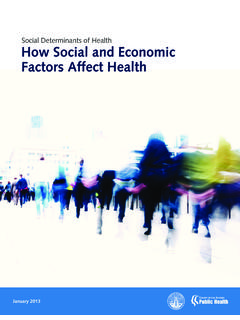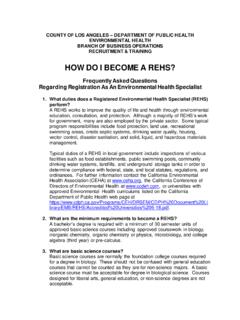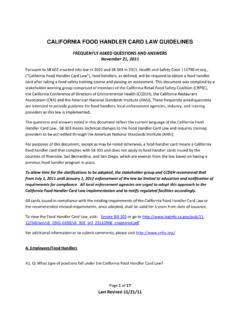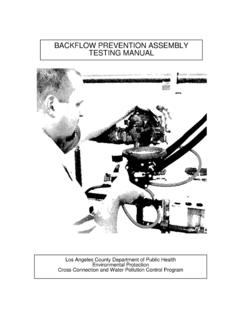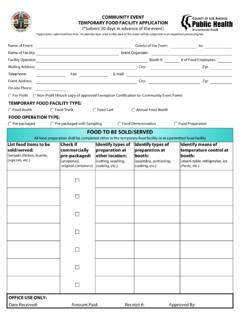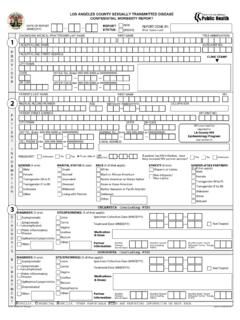Transcription of INDICATORS OF HEALTH
1 HEALTH INDICATORS are useful tools for monitoring the HEALTH of the population and commu-nicating with multiple audiences about opportunities to improve HEALTH . These INDICATORS are designed to reflect the broad contributors to HEALTH social and physical environments,behaviors, and HEALTH conditions. Most importantly, they invite action by an increasinglybroad range of individuals and organizations who share some responsibility for HEALTH , evenif their primary mission falls outside the traditional domain of HEALTH care or public HEALTH . The conditions represented by these INDICATORS point to real opportunities for has shown the high rate of return on public HEALTH investments. In fact, invest-ments in prevention during the past century are estimated to account for 25 of the 30 yearsgained in average life expectancy in the For example, vaccines to protect children frompolio and other infectious diseases, improvements in motor vehicle safety, safer and healthierfoods, and clean drinking water, have saved lives and prevented disability.
2 Furthermore, thecosts associated with preventable disease and disability are high. For example, in Los AngelesCounty, the direct medical and indirect costs of obesity are estimated at $ billion, andsmoking at $ billion, annually. Wise investments in policy and program-based strategies can yield enormous payoffswhether implemented in schools, worksites, HEALTH care facilities, or in community interventions can be especially cost-effective ways to prevent disease and include implementing nutritional standards on school campuses, taxes on alcohol,and protocols to enhance workplace safety. In HEALTH care settings, smoking cessation counsel-ing by physicians and age-appropriate cancer screening are examples of cost-effective ways toprevent disease and improve HEALTH outcomes. Community-based interventions may includeimproving physical activity curricula in schools, upgrading parks and recreation facilities, andproviding safe after-school activities for youth.
3 Proven effective approaches to improvinghealth exist, and we must utilize them to get the highest return on our collective hope that the information in this report provides a rich snapshot of HEALTH in LosAngeles County. Please note that statistical comparisons to the average should not alwayssuggest that the average is desirable or acceptable. For example, the fact that smoking rateshave declined to their lowest level in over two decades of monitoring is good news; however,none would argue that a smoking rate above zero yields the best possible HEALTH encourage your feedback and partnership in attaining better HEALTH for all. Jonathan E. Fielding, MD, MPHD irector of Public HEALTH and HEALTH OfficerA PUBLICATION OF LOS ANGELES COUNTY DEPARTMENT OF HEALTH SERVICES PUBLIC HEALTHKEYINDICATORSOF HEALTHBY SERVICE PLANNING AREA POPULATION RANKINGP opulations of County SPAs and individual states by York (9,519,338)10.
4 New Jersey 11. Georgia Carolina 13. Virginia 15. Indiana 16. Washington 17. Tennessee 20. Maryland 22. Minnesota 23. Louisiana 25. Colorado 26. Kentucky Carolina 29. Oregon 30. Connecticut 31. Iowa 32. Mississippi 33. Kansas 34. Arkansas 36. Nevada 2 San Fernando (1,981,961)38. New Mexico Virginia 3 San Gabriel (1,734,254)41. Nebraska 8 South Bay (1,500,185)43. Idaho 7 East (1,285,210)45. Maine 46. New Hampshire 47. Hawaii 4 Metro (1,144,083) Island 6 South (955,054) 52. Delaware 53. South Dakota Dakota 55. Alaska 5 West (613,191) of Columbia 59. 1 Antelope Valley (305,400)This publication, Key INDICATORS of HEALTH ,provides data for over 60 HEALTH indicatorsfor County and each of the county seight Service Planning Areas (or SPAs).These areas form the organizational basisfor many efforts to improve HEALTH .
5 Assuch, it is vital that we track HEALTH indica-tors at the SPA level over time. As depict-ed in the population ranking (at right),many of County s SPAs are comparablewith several states in total any of the Public HEALTH Programs orcontact any of the eight SPA Offices Long BeachRolling HillsTorranceCarsonHawthorneRedondo BeachCerritosMontebelloWhittierDowneyNor walkVernonLos AngelesLynwoodComptonLos AngelesSanta MonicaMalibuBeverly HillsLos AngelesWest HollywoodAzusaPasadenaAlhambraArcadiaEl MonteDiamond BarPomonaSan DimasSan FernandoSanta ClaritaVal VerdeGlendaleBurbankLos AngelesCalabasasLancasterPalmdaleQuartz HillLittlerockLake Los AngelesSERVICE PLANNING AREAS (SPAs) BOUNDARIESSPA 1 Antelope ValleySPA 2 San FernandoSPA 3 San GabrielSPA 4 MetroSPA 5 WestSPA 6 SouthSPA 7 EastSPA 8 South CountyHealthy People 2010includes Catalina IslandA USER S GUIDE TO COLOREach SPA is designated by a specific color, asseen below and at right, that is continuedthroughout this for County is highlighted along withnotations that show whether a particular SPA isfaring better or worse than the County average, based on statistical addition, the Healthy People 201021objec-tives are provided where available and comparableto the indicator .
6 Approximately 40% of all deaths in theUnited States are linked to smoking, physicalinactivity, poor nutrition, alcohol abuse, andother drug community-basedand HEALTH care provider interventions havebeen proven to reduce these and otherhealth risk behaviors, and to increasehealth-promoting BEHAVIORSA ntelope ValleySan FernandoSan GabrielMetroWestSouthEastSouth BaySPA 1 SPA 2 SPA 3 SPA 4 SPA 5 SPA 6 SPA 7 SPA 8 Healthy People 2010 Los Angeles County Key INDICATORS of HEALTH by Service Planning Area 2002/2003 Alcohol and Drug Use Rate of drug-related death among adults (age-adjusted per 100,000 population) Percent of all adults who binge drink had 5 or more alcoholic drinks (4 for women) on at least one occasion in the past 30 Percent of teens ages 14 17 who drink consumed at least one alcoholic drink in the past 30 days3 (Los Angeles Unified School District only) Use Percent of adults who smoke Percent of teens ages 14 17 years who smoke cigarettes3 (Los Angeles Unified School District only) Children4 Percent of children in grades 5, 7 & 9 who are overweight (BMI above the 95th percentile) and Obese Adults1b Percent of adults who are overweight ( BMI < ) Rates of binge drinking,when calculated amongonly those who reportedany drinking in the pastmonth, were 32% amongadults and 49% amongteens (ages 14-17 years).
7 1a & 3 Adult obesityincreasedfrom 14% in 1997 to19% in Adult obesitywas highestamong African-Americans(31%) followed byLatinos (24%), Whites(16%), and Asians/PacificIslanders (6%).1b 25% of boys and 18% of girls attending publicschools in grades 5, 7 and 9 are Physical activitydoes nothave to be strenuous inorder to be in 30 minutesof moderate physicalactivity( , walking)each day improves healthand reduces the risk ofdeveloping There are over one million adult smokersin Los Angeles Adult cigarette smokingdecreased from 18% in1999 to 16% in The rate of smokingamong men (20%) isnearly twice that ofwomen (11%).1 among women, rates of smokingare higheramong African-Americans(19%) and Whites (16%)compared to Asians/Pacific Islanders (7%) and Latinas (7%).1 Percent of adults who are obese (BMI 30) Activity Percent of adults who are physically active obtain recommended amount of exercise each week1 Percent of adults who are sedentary1 Percent of adults who consume five or more servings of fruits and vegetables a were not available where noted =SPA statistically better off than the County average (p< )=SPA statistically worse off than the County average (p< )
8 N/A Conditions in the social and physical environmentexert powerful influences on individual to maximize the HEALTH of the populationmust include policies and other interventions thatsupport family and neighborhood cohesion,strengthen social networks, improve educationalopportunities, foster a strong economy, and pro-mote safe workplaces and clean & PHYSICAL ENVIRONMENTKey INDICATORS of HEALTH by Service Planning Area 2002/2003 Antelope ValleySan FernandoSan GabrielMetroWestSouthEastSouth BaySPA 1 SPA 2 SPA 3 SPA 4 SPA 5 SPA 6 SPA 7 SPA 8 Healthy People 2010 Los Angeles County Air Quality Percent of days (per year) that state standards for air quality were not met5 Percent of children ages 0 5 years who are regularly exposed to tobacco smoke at Percent of population with household incomes less than 100% of the Federal Poverty Safety1 Percent of adults who believe their neighborhood is to Play1 Percent of children ages 1 17 years whose parents say that they can easily get to a park, playground or other safe place to Public high school dropout The percentage of daysthat state standards for air qualitywere not metincreased from 14% in1999 to 24% in Research has shown that safe neighborhoodenvironments positivelyinfluence Reading to childrenpositively impacts out-comes such as languagedevelopment, emergentliteracy and Research has shown a correlation between childhood obesity andtotal hours of sedentarybehavior (including television watching).
9 Minimizing televisionviewing is a possibleintervention for reducingchildhood were not available where noted =Statistical comparisons with County were not performed =SPA statistically better off than the County average (p< )=SPA statistically worse off than the County average (p< )Reading to Child1 Percent of children ages 0 5 years who are read to daily by a parent or family Viewing1 Percent of children ages 6 months to 17 years who watch 3 or more hours of television per Support1 Percent of children ages 0 5 years whose parents say it is very or somewhat easy to find someone to talk to when they need advice about raising their Care1 Percent of children ages 0 5 years for whom parents report difficulty finding adequate HEALTH is a state of physical, mental, andsocial well-being, and not merely theabsence of disease. HEALTH includes theability to function effectively in the face ofchanging circumstances.
10 People s percep-tions of their HEALTH and level of function areamong the strongest predictors of lifeexpectancy and HEALTH care STATUSKey INDICATORS of HEALTH by Service Planning Area 2002/2003 Antelope ValleySan FernandoSan GabrielMetroWestSouthEastSouth BaySPA 1 SPA 2 SPA 3 SPA 4 SPA 5 SPA 6 SPA 7 SPA 8 Healthy People 2010 Los Angeles County Perceived Health1 Percent of adults reporting their HEALTH to be fair to Percent of children ages 0 17 years who are perceived by their parents to be in fair to poor * Limitation among Adults1 Average number of days (in past month) when regular daily activities were limited due to poor physical/mental Percent of adults with a and Special HEALTH Care Needs among Children1g Percent of children ages 0 17 years that have special HEALTH care needs among adults and children, fair to poorhealth statusis inverselyassociated with income:38% of adults and 25%of children living at orbelow poverty (<100%FPL) are in fair to poorhealth;8% of adults and4% of children withhousehold incomes above300% FPL are in fair topoor The average number of days that normal dailyactivities are limited due to poor physical or mental healthin thepast month are highestamong those withincomes below poverty (4 days) and lowestamong those withincomes above 300% ofpoverty ( days).
